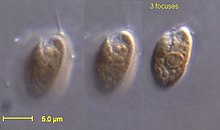
Back Cryptista BS Cryptista English Cryptista Spanish Cryptista French Cryptista Hungarian クリプチスタ Japanese 크립티스타 Korean Cryptista Portuguese Cryptista SIMPLE Cryptista Ukrainian
| Cryptista | |
|---|---|
 | |
| Classificazione filogenetica | |
| Dominio | Eukaryota |
| (clade) | (sottodominio) Bikonta |
| (clade) | (supergruppo) Eubikonta |
| (clade) | (gruppo) Diaphoretickes |
| (clade) | (sottogruppo) EuDiaphoretickes |
| (clade) | (superregno) Cryptista |
| Classificazione classica | |
| Dominio | Eukaryota |
| Regno | Chromista |
| Sottoregno | Hacrobia |
| Phylum | CriptystaAdl et al., 2018 [Cavalier-Smith 1989, 2018][1] |
| subphylum (classica) | |
| Regni (filogenetica) | |
Cryptista è un clade di eucarioti simili ad alghe. È molto probabilmente correlato a Archaeplastida che comprende piante e molte alghe, all'interno del gruppo più ampio Diaphoretickes.[2]
Sebbene a volte sia stato collocato insieme ad Haptista nel gruppo Hacrobia, all'interno del regno Chromista,[3] studi più recenti hanno scoperto che Hacrobia non è un clade.[4] Ad esempio, nel 2016, un ampio studio filogenomico ha rilevato che i criptisti rientrano nel gruppo Archaeplastida, mentre gli aptofiti sono strettamente correlati al supergruppo SAR.[5][6]
- ^ Sina M. Adl, David Bass, Christopher E. Lane, Julius Lukeš, Conrad L. Schoch, Alexey Smirnov, Sabine Agatha, Cedric Berney e Matthew W. Brown, Revisions to the Classification, Nomenclature, and Diversity of Eukaryotes, in The Journal of Eukaryotic Microbiology, vol. 66, n. 1, 26 settembre 2018, pp. 4–119, DOI:10.1111/jeu.12691, ISSN 1550-7408, PMC 6492006, PMID 30257078.
- ^ Adl SM, Bass D, Lane CE, Lukeš J, Schoch CL, Smirnov A, Agatha S, Berney C, Brown MW, Burki F, Cárdenas P, Čepička I, Chistyakova L, Del Campo J, Dunthorn M, Edvardsen B, Eglit Y, Guillou L, Hampl V, Heiss AA, Hoppenrath M, James TY, Karnkowska A, Karpov S, Kim E, Kolisko M, Kudryavtsev A, Lahr DJ, Lara E, Le Gall L, Lynn DH, Mann DG, Massana R, Mitchell EA, Morrow C, Park JS, Pawlowski JW, Powell MJ, Richter DJ, Rueckert S, Shadwick L, Shimano S, Spiegel FW, Torruella G, Youssef N, Zlatogursky V, Zhang Q, Revisions to the Classification, Nomenclature, and Diversity of Eukaryotes, in The Journal of Eukaryotic Microbiology, vol. 66, n. 1, gennaio 2019, pp. 4–119, DOI:10.1111/jeu.12691, PMC 6492006, PMID 30257078.
- ^ Michael A. Ruggiero, Dennis P. Gordon, Thomas M. Orrell, Nicolas Bailly, Thierry Bourgoin, Richard C. Brusca, Thomas Cavalier-Smith, Michael D. Guiry e Paul M. Kirk, A Higher Level Classification of All Living Organisms, in PLOS ONE, vol. 10, n. 4, 29 aprile 2015, pp. e0119248, Bibcode:2015PLoSO..1019248R, DOI:10.1371/journal.pone.0119248, ISSN 1932-6203, PMC 4418965, PMID 25923521.
- ^ Burki F, Roger AJ, Brown MW, Simpson AG, The New Tree of Eukaryotes, in Trends in Ecology & Evolution, vol. 35, n. 1, gennaio 2020, pp. 43–55, DOI:10.1016/j.tree.2019.08.008, PMID 31606140.
- ^ Burki F, Kaplan M, Tikhonenkov DV, Zlatogursky V, Minh BQ, Radaykina LV, Smirnov A, Mylnikov AP e Keeling PJ, Untangling the early diversification of eukaryotes: a phylogenomic study of the evolutionary origins of Centrohelida, Haptophyta and Cryptista., in Proc Biol Sci, vol. 283, n. 1823, 2016, pp. 20152802, DOI:10.1098/rspb.2015.2802, PMC 4795036, PMID 26817772.
- ^ Burki, F, Inagaki, Y, Bråte, J, Archibald, J., Keeling, P., Cavalier-Smith, T, Sakaguchi, M, Hashimoto, T, Horak, A, Kumar, S, Klaveness, D, Jakobsen, K.S, Pawlowski, J e Shalchian-Tabrizi, K, Large-scale phylogenomic analyses reveal that two enigmatic protist lineages, Telonemia and Centroheliozoa, are related to photosynthetic chromalveolates., in Genome Biology and Evolution, vol. 1, 2009, pp. 231–8, DOI:10.1093/gbe/evp022, PMC 2817417, PMID 20333193.
